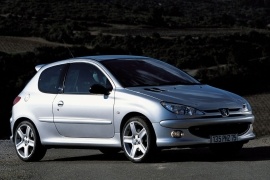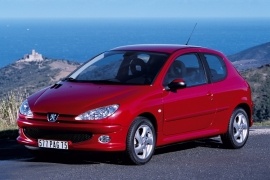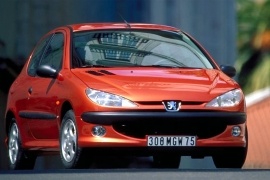PEUGEOT 206 3 Doors Models/Series Timeline, Specifications & Photos
First production year: 1998
Engines: Gasoline, Diesel
Body style: Hatchback
Peugeot had a lot of racing history and many titles on its shelf when it decided to build one of the last naturally aspirated, manual gearbox, light, and nimble cars from its lineup: the 206 RC.
The hot-hatch war was partly moved from the compact-segment to the super-mini. The Renault Clio Renault Sport opened the appetite for it and the next in line that followed was the Peugeot. About the same time, the Honda Civic Type R brought the EP3 version, with its 8000 rpm screaming engine and 200 hp. But that was too expensive, so the Europeans were left to chose between the French brands for naturally aspirated engines. All of the others were turbocharged.
On the outside, the little 206 RC (or GTI 180 as it was named in the U.K.) featured a longer roof-spoiler then the regular 138 hp GTI. In the front, the lower apron was slightly modified to look more aggressive. A new set of 17” light-alloy wheels completed the sporty package. It was available only on the 3-doors bodywork, like its famous ancestor, the 205 GTI.
The interior was more race-inspired than other Peugeot vehicles. The Recaro sport-bucket seats featured a non-adjustable headrest and a hole for a harness, even though there was no race harness installed. But it looked good. The aluminum pedals and gear-stick knob enhanced the “racy” look of the vehicle. The car-maker installed a short-shifter for the 206 RC.
The car's heart was a 2.0-liter naturally aspirated engine with variable valve timing and modified inlet and exhaust manifolds. It was mated to a standard 5-speed gearbox. The four-wheel brake-discs were fitted as standard.
After four years on the market, Peugeot refreshed the 206 lineups and improved it with more fuel-efficient engines and upgraded materials, and that update was also reflected on the nimble, three-door version as well as on the five-door hatchback, the station wagon, and the coupe-cabriolet.
Designed mostly for those who needed a light, easy to run, and affordable to buy vehicle, the 206 started to slightly show its age. But the carmaker still had enough aces in its sleeves to make it look fresh again and, moreover, enhanced the engine lineup with the addition of a few powerplants while dropping some of the older ones.
Perhaps the most important update was on the front fascia. While at first glance, it didn't look that much changed, the clear-lens headlights that replaced the previous ones made the car keep its edge as an appealing car in the segment. Moreover, the black, unpainted rubber trims on the bumpers and on the sides were replaced with body-colored ones. Also, the apron sported a different design, with a broader grille, enhancing the cooling capacity. For the three-door version, the carmaker kept the pop-out rear windows, which proved to be useful, especially on the vehicles not fitted with an air-conditioning unit.
Inside, there were new, higher-grade materials and a redesigned instrument cluster. They offered a cleaner look thanks to their silver rings around the dials. The pedals were also softer and kept their unusual position which helped the women find a better driving position when wearing high heels.
Under the hood, Peugeot installed a wide engine range, including a newly developed 1.4-liter turbo-diesel that sipped fuel and offered a very long range for the little French car. For those interested in a sportier version, the carmaker also offered a 138 PS (136 HP) version.
PEUGEOT 206 3 Doors 1.1L 5MT FWD (60 HP)
PEUGEOT 206 3 Doors 1.4L 16V 4AT FWD (90 HP)
PEUGEOT 206 3 Doors 1.4L 16V 5MT FWD (90 HP)
PEUGEOT 206 3 Doors 1.4L 4AT FWD (75 HP)
PEUGEOT 206 3 Doors 1.4L 5MT FWD (75 HP)
PEUGEOT 206 3 Doors 1.6L 16V 4AT FWD (110 HP)
Peugeot introduced the 206 in 1998 as a replacement for the long-gone 205 and remained in production for more than two decades in various markets worldwide.
The small-size segment was highly contested in Europe when the 206 appeared on the market. It faced stiff competition from Renault's Clio, Volkswagen's Polo, and Opel's Corsa. And yet, Peugeot made it slightly better by offering the car as a hatchback with three or five doors, a station wagon, a sedan, and a hard top coupe-cabriolet.
In the three-door version, the 206 showed a sporty appearance with headlights resembling a feline pair of eyes. The narrow grille featured a horizontal slat, while the main cooling area was located in the apron where a second grille was found. This version of the 206 featured longer doors and pop-out rear windows, like its famous predecessor. Moreover, the C-pillars featured a wider lower area which, in turn, decreased the driver's rear three-quarter visibility, but it looked better from the outside. At the back, the tailgate was flanked by the taillights, which made a cut through the liftgate's panel.
When it was launched, Peugeot's stated that it designed the car with the feminine customers in mind. Thus, it was the first vehicle that sported pedals adapted for driving with high heels. Moreover, the rear seats offered enough room for two passengers, while the split-folding bench expanded the trunk for a longer shopping session.
Under the hood, the carmaker installed a wide engine choice ranging from a 1.1-liter gasoline unit to a sporty 2.0-liter. Last but not least, the car was available with a few turbo-diesel powerplants that proved to be highly fuel-efficient.


